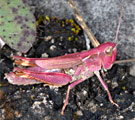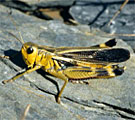Isophya rhodopensis Ramme, 1951
![Isophya rhodopensis: Männchen (Ostrhodopen NE Alexandroupolis, Ende Mai 2019) [N] Isophya rhodopensis: Männchen (Ostrhodopen NE Alexandroupolis, Ende Mai 2019) [N]](thumbs/tettigoniidae/rhodopensis_im2019.jpg)
![Isophya rhodopensis: Männchen (Ostrhodopen NE Alexandroupolis, Ende Mai 2019) [N] Isophya rhodopensis: Männchen (Ostrhodopen NE Alexandroupolis, Ende Mai 2019) [N]](thumbs/tettigoniidae/rhodopensis_2im2019.jpg)
![Isophya rhodopensis: Männchen (Ostrhodopen NE Alexandroupolis, Ende Mai 2019) [M] Isophya rhodopensis: Männchen (Ostrhodopen NE Alexandroupolis, Ende Mai 2019) [M]](thumbs/tettigoniidae/rhodopensis_3im2019.jpg)
![Isophya rhodopensis: Männchen (Ostrhodopen NE Alexandroupolis, Ende Mai 2019) [M] Isophya rhodopensis: Männchen (Ostrhodopen NE Alexandroupolis, Ende Mai 2019) [M]](thumbs/tettigoniidae/rhodopensis_4im2019.jpg)
![Isophya rhodopensis: Weibchen (NE-Griechenland, Thrakien, E-Rhodopen NE Alexandoupolis, Ende Mai 2019) [N] Isophya rhodopensis: Weibchen (NE-Griechenland, Thrakien, E-Rhodopen NE Alexandoupolis, Ende Mai 2019) [N]](thumbs/tettigoniidae/rhodopensis_5im2019.jpg)
![Isophya rhodopensis: Weibchen (NE-Griechenland, Thrakien, E-Rhodopen NE Alexandoupolis, Ende Mai 2019) [N] Isophya rhodopensis: Weibchen (NE-Griechenland, Thrakien, E-Rhodopen NE Alexandoupolis, Ende Mai 2019) [N]](thumbs/tettigoniidae/rhodopensis_6im2019.jpg)
![Isophya rhodopensis: Weibchen (NE-Griechenland, Thrakien, E-Rhodopen NE Alexandoupolis, Ende Mai 2019) [N] Isophya rhodopensis: Weibchen (NE-Griechenland, Thrakien, E-Rhodopen NE Alexandoupolis, Ende Mai 2019) [N]](thumbs/tettigoniidae/rhodopensis_7im2019.jpg)
![Isophya rhodopensis: Weibchen (NE-Griechenland, Thrakien, E-Rhodopen NNE Alexandoupolis, Ende Mai 2019) [N] Isophya rhodopensis: Weibchen (NE-Griechenland, Thrakien, E-Rhodopen NNE Alexandoupolis, Ende Mai 2019) [N]](thumbs/tettigoniidae/rhodopensis_8im2019.jpg)
![Isophya rhodopensis: Weibchen (NE-Griechenland, Thrakien, E-Rhodopen NNE Alexandoupolis, Ende Mai 2019) [N] Isophya rhodopensis: Weibchen (NE-Griechenland, Thrakien, E-Rhodopen NNE Alexandoupolis, Ende Mai 2019) [N]](thumbs/tettigoniidae/rhodopensis_9im2019.jpg)
![Isophya rhodopensis: Weibchen (NE-Griechenland, Thrakien, E-Rhodopen NNE Alexandoupolis, Ende Mai 2019) [N] Isophya rhodopensis: Weibchen (NE-Griechenland, Thrakien, E-Rhodopen NNE Alexandoupolis, Ende Mai 2019) [N]](thumbs/tettigoniidae/rhodopensis_10im2019.jpg)
![Isophya rhodopensis: Weibchen (NE-Griechenland, Thrakien, E-Rhodopen NNE Alexandoupolis, Ende Mai 2019) [N] Isophya rhodopensis: Weibchen (NE-Griechenland, Thrakien, E-Rhodopen NNE Alexandoupolis, Ende Mai 2019) [N]](thumbs/tettigoniidae/rhodopensis_11im2019.jpg)
![Isophya rhodopensis: Weibchen (NE-Griechenland, Thrakien, E-Rhodopen NNE Alexandoupolis, Ende Mai 2019) [N] Isophya rhodopensis: Weibchen (NE-Griechenland, Thrakien, E-Rhodopen NNE Alexandoupolis, Ende Mai 2019) [N]](thumbs/tettigoniidae/rhodopensis_12im2019.jpg)
![Isophya rhodopensis: Weibchen (NE-Griechenland, Thrakien, E-Rhodopen NNE Alexandoupolis, Ende Mai 2019) [N] Isophya rhodopensis: Weibchen (NE-Griechenland, Thrakien, E-Rhodopen NNE Alexandoupolis, Ende Mai 2019) [N]](thumbs/tettigoniidae/rhodopensis_13im2019.jpg)
![Isophya rhodopensis: Weibchen (NE-Griechenland, Thrakien, E-Rhodopen NNE Alexandoupolis, Ende Mai 2019) [M] Isophya rhodopensis: Weibchen (NE-Griechenland, Thrakien, E-Rhodopen NNE Alexandoupolis, Ende Mai 2019) [M]](thumbs/tettigoniidae/rhodopensis_14im2019.jpg)
![Isophya rhodopensis: Weibchen (NE-Griechenland, Thrakien, E-Rhodopen NNE Alexandoupolis, Ende Mai 2019) [M] Isophya rhodopensis: Weibchen (NE-Griechenland, Thrakien, E-Rhodopen NNE Alexandoupolis, Ende Mai 2019) [M]](thumbs/tettigoniidae/rhodopensis_15im2019.jpg)
![Isophya rhodopensis: Weibchen (NE-Griechenland, Thrakien, E-Rhodopen NNE Alexandoupolis, Ende Mai 2019) [M] Isophya rhodopensis: Weibchen (NE-Griechenland, Thrakien, E-Rhodopen NNE Alexandoupolis, Ende Mai 2019) [M]](thumbs/tettigoniidae/rhodopensis_16im2019.jpg)
![Isophya rhodopensis: Männchen (NE-Griechenland, Berge NW von Drama, Anfang Juni 2019) [N] Isophya rhodopensis: Männchen (NE-Griechenland, Berge NW von Drama, Anfang Juni 2019) [N]](thumbs/tettigoniidae/rhodopensis_17im2019.jpg)
![Isophya rhodopensis: Männchen (NE-Griechenland, Berge NW von Drama, Anfang Juni 2019) [N] Isophya rhodopensis: Männchen (NE-Griechenland, Berge NW von Drama, Anfang Juni 2019) [N]](thumbs/tettigoniidae/rhodopensis_18im2019.jpg)
![Isophya rhodopensis: Männchen (NE-Griechenland, Berge NW von Drama, Anfang Juni 2019) [N] Isophya rhodopensis: Männchen (NE-Griechenland, Berge NW von Drama, Anfang Juni 2019) [N]](thumbs/tettigoniidae/rhodopensis_19im2019.jpg)
![Isophya rhodopensis: Männchen (NE-Griechenland, Berge NW von Drama, Anfang Juni 2019) [M] Isophya rhodopensis: Männchen (NE-Griechenland, Berge NW von Drama, Anfang Juni 2019) [M]](thumbs/tettigoniidae/rhodopensis_20im2019.jpg)
![Isophya rhodopensis: Männchen (NE-Griechenland, Berge NW von Drama, Anfang Juni 2019) [M] Isophya rhodopensis: Männchen (NE-Griechenland, Berge NW von Drama, Anfang Juni 2019) [M]](thumbs/tettigoniidae/rhodopensis_21im2019.jpg)
![Isophya rhodopensis: Weibliche Larve (NE-Griechenland, Berge NW von Drama, Anfang Juni 2019) [N] Isophya rhodopensis: Weibliche Larve (NE-Griechenland, Berge NW von Drama, Anfang Juni 2019) [N]](thumbs/tettigoniidae/rhodopensis_22im2019.jpg)
![Isophya rhodopensis: Habitat (NE-Griechenland, Thrakien, E-Rhodopen NNE Alexandoupolis, Ende Mai 2019) [N] Isophya rhodopensis: Habitat (NE-Griechenland, Thrakien, E-Rhodopen NNE Alexandoupolis, Ende Mai 2019) [N]](thumbs/tettigoniidae/rhodopensis_h2019.jpg)
![Isophya rhodopensis: Habitat (Thrakien, NE Alexandroupolis, Ende Mai 2019) [N] Isophya rhodopensis: Habitat (Thrakien, NE Alexandroupolis, Ende Mai 2019) [N]](thumbs/tettigoniidae/rhodopensis_2h2019.jpg)
Lebensraumansprüche:
Isophya rhodopensis besiedelt Wiesen und Weiden mit meist hohem Kraut- und Gebüschanteil, Waldränder, Lichtungen und Berghänge.
Entwicklungszyklus:
Isophya rhodopensis wird in tieferen Lagen von Mai bis Juni oder Juli gefunden, in den Hochlagen dann mehr im Sommer und vereinzelt sogar bis September. Die Töne der Männchen sind auch für das menschliche Ohr gut zu hören.
Bemerkungen:
Isophya rhodopensis kommt in Südbulgarien und Nordostgriechenland im Umfeld der Rhodopen und angrenzender Bereiche in drei Unterarten vor: ssp. rhodopensis, ssp. leonorae und ssp. petkovi.
Isophya camptoxypha | Isophya hospodar | Isophya kraussii | Isophya miksici | Isophya modesta | Isophya pienensis | Isophya pyrenaea | Isophya rectipennis | Isophya speciosa | Isophya tosevski


